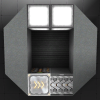- Joined
- May 19, 2015
- Messages
- 19
- Reaction score
- 14
Hello, fellow StarMade players!
As a docking and standardization enthusiast, I have been been following the development of the community's USD docking standard very closely and I am a big fan of the current result, which I will be referring to in this video as "Draft USD". However, as several players have mentioned, there is one major use case that is not covered by the USD standard so far: very small spacecraft, such as short-range or carrier-based fighters.
To that end, I would like to introduce my proposal for what I am calling: microUSD.
Here I have a small fighter that I call a Sentinel. As you can see, it is much too small to support Draft USD. However, I would still like to dock it to stations or ships in such a way that the connection appears to seal. The solution: microUSD.
The docking connector portion of microUSD is identical to Draft USD, so they are mechanically compatible for docking spacecraft together purely for structural connectivity without the capacity for crew or cargo transfer through the hatch.
The difference lies in the fact that the hatch is located directly between the docking blocks and is only 1x1 rather than 3x3. For aesthetic reasons, I have elected to position the rail docker aft of the hatch facing forward, and the basic rail forward facing aft, although these positions could be reversed in a final standard. Unlike Draft USD, these positions are reversed on the support craft that the fighter is docked to for the same reasons of symmetry that an image in a mirror appears reversed horizontally but not vertically.
In terms of egress, the optimal position for microUSD is on the top of the fighter and the bottom of the support craft. This allows a pilot to enter from the support craft's gravity simply by dropping down into the fighter. The pilot can re-enter the support craft by moving upward independent of gravity after exiting the fighters core.
This configuration was inspired by the egress method on TIE fighters in Star Wars in which pilots enter fighters mounted on rails from catwalks into a top hatch. As such, this configuration also works inside of hangar bays.
microUSD is not, however, limited to solely this orientation and will work when aligned in any direction when used in combination with directional gravity, even horizontally.
Thank you for viewing my proposal. I would appreciate your support for including microUSD in the community's USD docking standard. Together, we can make sure no fighter is left behind.
As a docking and standardization enthusiast, I have been been following the development of the community's USD docking standard very closely and I am a big fan of the current result, which I will be referring to in this video as "Draft USD". However, as several players have mentioned, there is one major use case that is not covered by the USD standard so far: very small spacecraft, such as short-range or carrier-based fighters.
To that end, I would like to introduce my proposal for what I am calling: microUSD.
Here I have a small fighter that I call a Sentinel. As you can see, it is much too small to support Draft USD. However, I would still like to dock it to stations or ships in such a way that the connection appears to seal. The solution: microUSD.
The docking connector portion of microUSD is identical to Draft USD, so they are mechanically compatible for docking spacecraft together purely for structural connectivity without the capacity for crew or cargo transfer through the hatch.
The difference lies in the fact that the hatch is located directly between the docking blocks and is only 1x1 rather than 3x3. For aesthetic reasons, I have elected to position the rail docker aft of the hatch facing forward, and the basic rail forward facing aft, although these positions could be reversed in a final standard. Unlike Draft USD, these positions are reversed on the support craft that the fighter is docked to for the same reasons of symmetry that an image in a mirror appears reversed horizontally but not vertically.
In terms of egress, the optimal position for microUSD is on the top of the fighter and the bottom of the support craft. This allows a pilot to enter from the support craft's gravity simply by dropping down into the fighter. The pilot can re-enter the support craft by moving upward independent of gravity after exiting the fighters core.
This configuration was inspired by the egress method on TIE fighters in Star Wars in which pilots enter fighters mounted on rails from catwalks into a top hatch. As such, this configuration also works inside of hangar bays.
microUSD is not, however, limited to solely this orientation and will work when aligned in any direction when used in combination with directional gravity, even horizontally.
Thank you for viewing my proposal. I would appreciate your support for including microUSD in the community's USD docking standard. Together, we can make sure no fighter is left behind.
Last edited:



